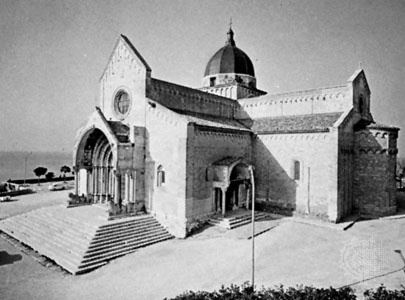Ancona
Italy
 capital of Ancona provincia and of Marche regione, in central Italy, on the Adriatic Sea on the farthest branch of the promontory that descends from the Conero massif. Founded by Syracusan colonists in about 390 BC, it was taken by Rome in the 2nd century BC and became a flourishing port, particularly favoured by the Roman emperor Trajan, who enlarged the harbour. Attacked by Goths, Lombards, and Saracens, Ancona declined but recovered its importance in the Middle Ages; it was one of the five cities of the Maritime Pentapolis under the Byzantine exarchate of Ravenna. The seat of a Carolingian march (frontier borderland), it eventually became a semi-independent republic under papal control; direct papal rule was established in 1532 and, with the exception of a period of French domination (1797–1816), was maintained until Ancona became part of Italy in 1860. The city was bombarded by the Austrian fleet (1915) during World War I and suffered severe damage from Allied bombings (1943–44) during World War II.
capital of Ancona provincia and of Marche regione, in central Italy, on the Adriatic Sea on the farthest branch of the promontory that descends from the Conero massif. Founded by Syracusan colonists in about 390 BC, it was taken by Rome in the 2nd century BC and became a flourishing port, particularly favoured by the Roman emperor Trajan, who enlarged the harbour. Attacked by Goths, Lombards, and Saracens, Ancona declined but recovered its importance in the Middle Ages; it was one of the five cities of the Maritime Pentapolis under the Byzantine exarchate of Ravenna. The seat of a Carolingian march (frontier borderland), it eventually became a semi-independent republic under papal control; direct papal rule was established in 1532 and, with the exception of a period of French domination (1797–1816), was maintained until Ancona became part of Italy in 1860. The city was bombarded by the Austrian fleet (1915) during World War I and suffered severe damage from Allied bombings (1943–44) during World War II.Notable landmarks, restored since the war, include the marble Arch of Trajan (AD 115); the 11th- to 12th-century Church of Santa Maria della Piazza, with an ornate facade dating from 1210 and remains of 5th- and 7th-century mosaics; and the 12th- to 13th-century Cathedral of San Ciriaco, which is supposed to occupy the site of a Roman temple of Venus and incorporates the remains of a basilica of the 5th–6th century. The city has many fine Gothic buildings and is the site of the National Museum of Marche, with a valuable archaeological collection and art gallery, although some local monuments suffered earthquake damage during the 1970s. Ancona is the seat of an archbishop.
The harbour, originally protected only by the elbow-shaped promontory from which the city takes its name (Greek angkon, “elbow”), has modern installations built since World War II, including a petroleum refinery. Although Ancona's importance as a port has diminished, it is a busy market centre, with ships plying between Italian and Croatian ports on the Adriatic. Ancona is on the main east-coast rail line from Milan and Bologna to Brindisi and Foggia; it is also connected to Rome by a main line. Industries include shipbuilding and the manufacture of machinery, chemicals, medicines, foodstuffs, textiles, furniture, and bricks. Pop. (2000 est.) mun., 98,329.
- Fonseca, Manuel da
- Fonseca, Manuel Deodoro da
- Fontainebleau
- Fontainebleau, school of
- Fontaine, Hippolyte
- Fontana
- Fontana, Carlo
- Fontana, Domenico
- Fontana, Lavinia
- fontanel
- Fontanes, Louis, marquis de
- Fontane, Theodor
- Font-de-Gaume
- Fontenelle, Bernard Le Bovier, sieur de
- Fontenoy, Battle of
- Fontevrault-l'Abbaye
- Fonteyn, Dame Margot
- Fontina
- Fontéchevade
- Fonvizin, Denis Ivanovich
- food
- food additive
- Food and Agriculture Organization
- Food and Drug Administration
- food chain